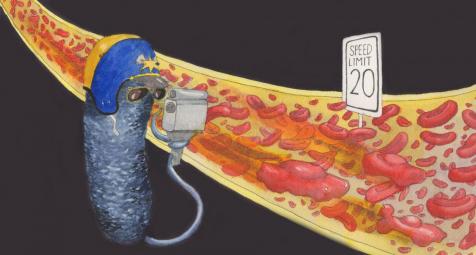
A team of Princeton University biologists and engineers led by Zemer Gitai bioengineered a real-time bacteria speedometer by linking a flow-detecting gene in Pseudomonas aeruginosa to one for illumination: The faster the flow, the brighter the glow. The flow detection is independent of force, prompting new questions about how bacteria sense their environments.
Illustration by Matilda Luk, Office of Communications
Princeton scientists bioengineer a cellular speedometer
Liz Fuller-Wright, Office of Communications, May 13, 2019 11 a.m.
An all-Princeton research team has identified bacteria that can detect the speed of flowing fluids.
Many kinds of cells can sense flow, just as our skin cells can feel the difference between a gentle breeze and a strong wind. But we depend on feeling the force involved, the push-back from the air against us. Without that push, we can’t distinguish speed; when the windows are closed, our skin can’t feel any difference in air force whether we are sitting in an office, a speeding car or a cruising airplane. But now, a team of Princeton researchers has discovered that some bacteria can in fact detect the speed of flow regardless of the force. Their paper appears in the online journal Nature Microbiology.
Click here for full story
